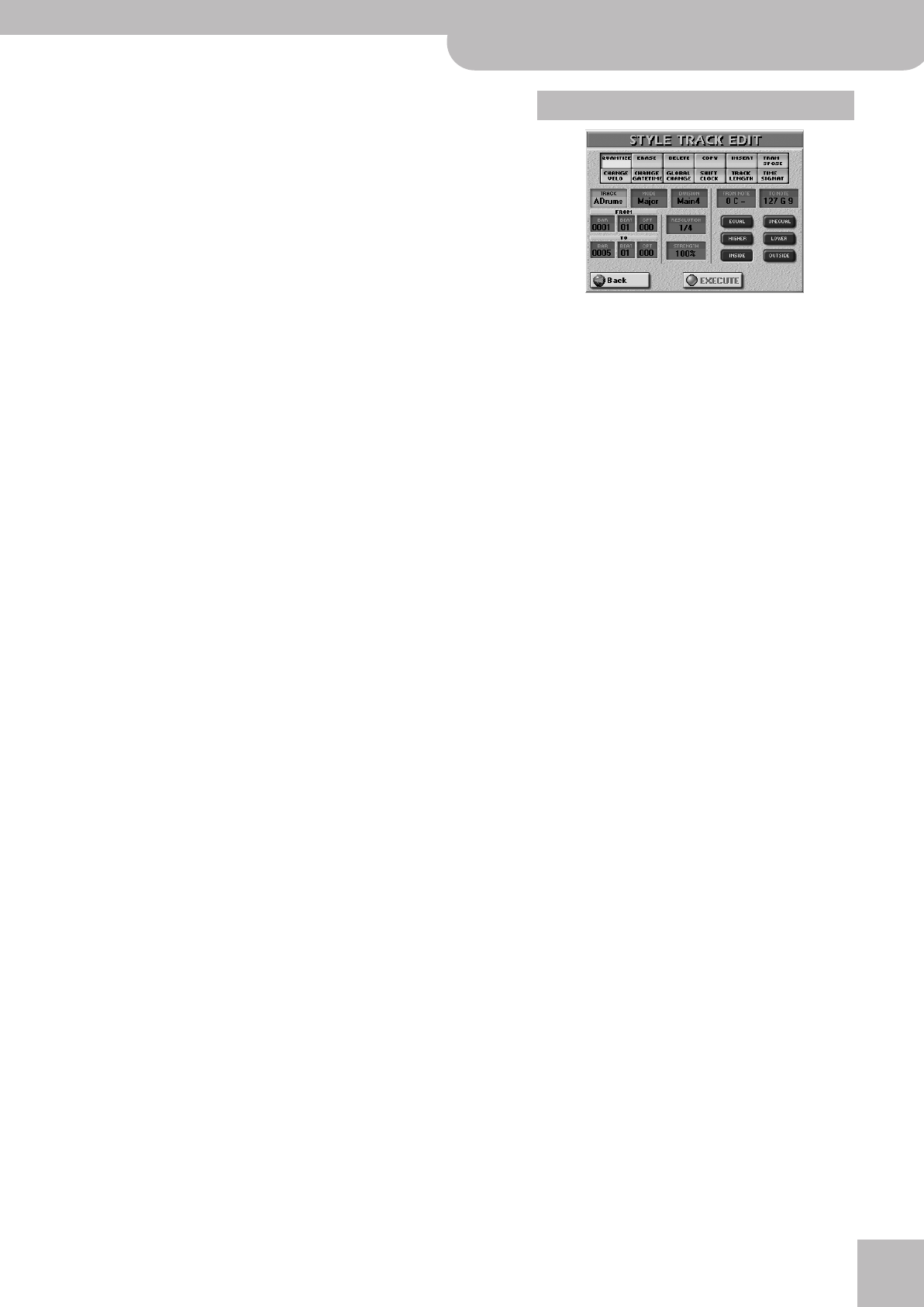
Style Track Edit functions
E-60/E-50 Music Workstation
r
163
(4) Press a field in the top two rows to select the
desired STYLE TRACK EDIT function.
If, after selecting one of these functions and setting
parameter values, you decide not to execute the
transformation, do not press the [EXECUTE] field.
(5) Select the tracks, Modes and Divisions you wish to
modify.
(6) Select the range (“FROM” and “TO”) for the edit
operation.
The FROM and TO parameters allow you to specify
the positions (measure/beat/clock) of the track
excerpt you want to change.
Example: to change measures 1~4 of the selected
track, enter the following values:
(7) Specify what you want to change and how it
should change: press one of the parameter fields
(to the right of the FROM/TO section) and use the
[DATA÷ENTRY] dial or the [DEC]/[INC] buttons.
(8) Confirm the operation by pressing the [EXECUTE]
field.
(9) Save your Style.
Use this function if you chose not to quantize your
music during recording and now realize that the tim-
ing is not quite what you expected it to be. If only
certain notes in a given time range need to be quan-
tized, you should narrow down the edit range using
the FROM/TO parameters.
■TRACK (ADrums~Acc6, ALL)
Allows you to select the track you wish to edit. You can
also select “ALL” here, in which case the operation applies
to all tracks.
■MODE
Allows you to select the Mode to be edited: “Major”,
“minor” or “7th”.
■DIVISION
Use this parameter to select the Division you want to edit:
Intro 1~4, Main 1~4, Fill Dwn 1~3, Fill Up 1~3, End 1~4.
■FROM
● BAR (1~[last measure of the track or pattern])—Refers
to the first measure to be edited. By default, the FROM
value is set to the beginning of the selected track(s).
● BEAT (1~[number of beats per bar])—Specifies the
beat position. The number of selectable beats depends
on the selected time signature.
● CPT (1~119)—Refers to the starting CPT position. “CPT”
is short for “Clock Pulse Time”, the smallest unit used by
the E-60/E-50. (There are 120 CPTs to every beat of a 4/4
bar.) Change this setting only if your edit operation
should start after the selected beat.
■TO
By default, the TO position is set to the last event of the
selected track (or the last event of the longest track when
you select “ALL”).
● BAR (1~[last measure of the track or pattern])—This is
where you specify the last measure to be edited.
● BEAT (1~[number of beats per bar])—Specifies the
beat position. The number of selectable beats depends
on the selected time signature.
● CPT (1~119)—Refers to the last clock that should be
affected by the edit operation. Change this setting only
if your edit operation should not end exactly on the
selected beat.
■FROM NOTE (0 C-~127 G9)
This parameter allows you to set the note (or lower limit of
the note range) to be modified within the specified FROM/
TO time range.
This parameter is not displayed when you select EQUAL,
UNEQUAL, HIGHER or LOWER.
FROM: BAR= 0001
BEAT= 01
CPT= 000
TO: BAR= 0005
BEAT= 01
CPT= 000
QUANTIZE
E-60_50_OM_UK.book Page 163 Thursday, June 22, 2006 10:06 AM


















